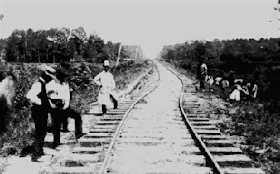 |
| Summerville's 1800's Victorian Style train station, moved to Ladson in 1900 as pictured here. |
Some of the wealthy residents of early coastal Charleston seeking refuge from the oppressive heat of summer and disease carrying insects of the coastal regions established a village among the shadows of Charleston County's tall pines. Summer retreat + village and voila, you have Summerville. As to the exact date the village received the name it was destined to be known by is not absolutely clear, but the fact there was an "Old Summerville" and a "New Summerville" is documented. The distinction occurred with the advent of the railroad.
In 1827, the South Carolina Canal and Railroad Company was organized and chartered by a group of citizens from Charleston. The railroad trustees eyed the emerging community of Summerville as a place to develop a large tract of land with a rail station as its center.
The tract of land would be a square grid in the form of a checkerboard with broad streets and every other square designated as parkland, a layout created by Thomas Jefferson in 1805 to fight yellow fever, a prevalent disease of coastal Colonial America. Called the Detmold Plan, it was named after the Company's most creative engineers, C.E. Detmold. The chosen tract of land was adjacent to what is now called "Old Summerville," the area of the first settlement where the wealthy planters built their summer residences.
In 1831, the tract of land was purchased and "New Summerville" was established - 1,500 acres at 37 cents an acre according to the Charleston Courier of Aug. 20, 1831. It was the first stop on a 136 mile planned railway line. The South Carolina Railroad when finished would extend from Charleston to Hamburg near Augusta, GA. Completed in 1833, it was honored with the distinction of being the longest railway line in the world and the first to carry U.S. mail. "Best Friend" was the name of first locomotive to operate on the line. It was also the first locomotive built in America. Destroyed in an accident, "Best Friend" was replaced with "The Phoenix."
In 1848, the first commuter train between Charleston and Summerville was begun, running in the summer months only, no doubt transporting the wealthy residents of Charleston to their summer retreats and back. Yellow fever epidemics ravaged Charleston between 1852 and 1858 leading to an upsurge in Summerville's population, which in time led to its famous reputation as a health resort. The commuter train began to operate throughout the year and continued to do so until its termination in the 1960's.
 |
| 1920's Town Square with train station in background |
 |
| Summerville's 1800's Victorian Style station at left-center |
Frank ordinarily would have been doubtfully apprehensive, but on this occasion he sensed the old man was being sincere. Frank quickly released the emergency flares called torpedoes, then turned to speak to the old man, but realized he was gone, as if he vanished into thin air.
Frank removed his pocket watch and glanced at it, the time was now 9:50 pm. At that moment, an eerie hissing sound enveloped the town followed by a massive explosion. The ground began to shake violently. Walls of nearby buildings began to collapse and swaying trees were ripped out of the ground by their roots. A massive earthquake struck Summerville and the surrounding areas of the Lowcountry leaving in its wake a path of tremendous and costly destruction - the largest recorded earthquake to ever hit the southeastern United States.
The train coming in from Jedburg was struck by the earthquake. The engineer applied the brakes to no avail. The shock waves mercilessly accelerated the train as the earth rolled up and down like the waves of the ocean. Miraculously, the train survived wave after wave. On its approach to Summerville, the engineer saw the warning flares and applied the brakes again. This time the engineer succeeded and the train of frightened passengers rolled to a stop a mile from Summerville with no one injured.
 |
| Damaged railroad tracks |
Frank Doar did not take any credit for being a hero. He was convinced the old man was an angel. At least, that is the way Frank told the story. Hey, it's October. I hope you enjoyed the article.

Great story. Guess no one will ever know the truth.
ReplyDeleteWhat House
Wonderful tale. Too bad Summerville's stations are gone. Where is the one moved to Ladson? I believe Goose Creek or Mt. Holly had/has an old one. May have been torn down. Thanks for an interesting story.
ReplyDelete